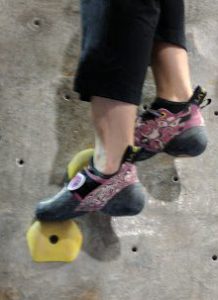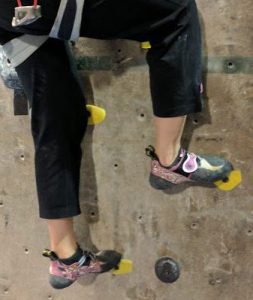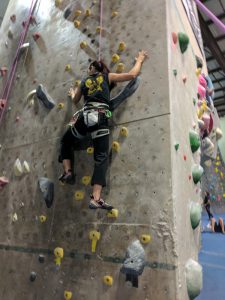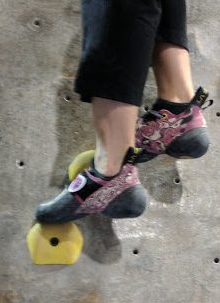Rock climbing is a fun and challenging sport for everyone at all ages with different sizes, weights, and body types. It is helpful to be in tip-top shape with strong upper body muscles. However, as an intermediate over 45+ woman climber, I found that having good core strength, adequate leg muscles, medium flexibility (not necessary to have a straddle split type of flexibility), and nice balance can go a long way in rock climbing. The good news is that all this can be learned and developed as well as tuning into your inner intuition for the mental strategy. Another great news for women is that we are intuitively balanced and innately flexible. We have a lower center of gravity than a man so that is also an advantage.
Learning Balance as a beginner
When I started climbing, I could barely do two full pull-ups. My legs and core are strong because of the distance running and yoga. Although after delivering two children, I slowed down a lot on my running and it was hard to find time for yoga practices. I could not rely on my upper body for strength because I have very little arm strength. To my surprise, sport climbing does not require as much upper body strength for beginners.
There are many rock climbing techniques to improve your skill as a climber and it can be overwhelming all at once. In this article, I will share some basic concepts to get started. Three key techniques for balancing on the rock wall for beginners are the body positioning, pivoting of your feet, and the shifting of weight from left to right and vice versa.
Body Positioning
Body position is an important factor in balancing.
First, find the center of gravity for your position that feels solid and have your hands and feet position on at least 3 points on the wall. You can use both feet and one hand positioning on 3 different holds while the free hand goes for the next move. Be aware of how your feet are placed on the holds. Are they perpendicular to the wall or are they side way parallel to the wall?
Pivoting
On most climbs, you would want your feet to be pivot-able for easier control for your next move. In order for you to be pivot-able, you

should be using the ball of your feet or your toes. When your feet are directly perpendicular to the wall, your hip is pushed out away from the wall which may cause you to fall. There will be a certain time when you want your feet to push your hip away from the wall. Most of the time, you want your hip hugs against the wall. This is when you want your feet to parallel or close to parallel the wall.
Shifting
When you pivot your toes or the ball of your feet, you will also need to be aware of which direction you will be climbing. In addition to climbing up, are you leaning toward the left or the right? This is when you will need to transfer your weight from your pivot foot to the other foot almost like a lunge shifting your hip left or right from one foot to the other.

Your height sometimes plays an important role in a challenging route. If you are short like me, 5’1-¾”, pivoting my toes (almost to tiptoeing) help me to reach further to the next hold. I need all the height I can muster up.
Your leg muscles especially those quadriceps and calves are much stronger than your arm muscles so make the most of your climb by using your legs and feet. Positioning, pivoting, and shifting of weight are key factors to your initial climbing techniques. Keep doing this and it will also tone your core abdomen muscles.
Practice
Find an easy route such as 5.6 ratings on a slab (rock wall at an angle less steep than the vertical wall). With the assistant of a belayer, climb without hands.

Only use your feet to move up. Your hands can prop against the walls but do not use it to grab any holds. Practice climbing up and climbing down. This will help you incorporate the three techniques: positioning, pivoting and shifting.
Climb on, my friends!

